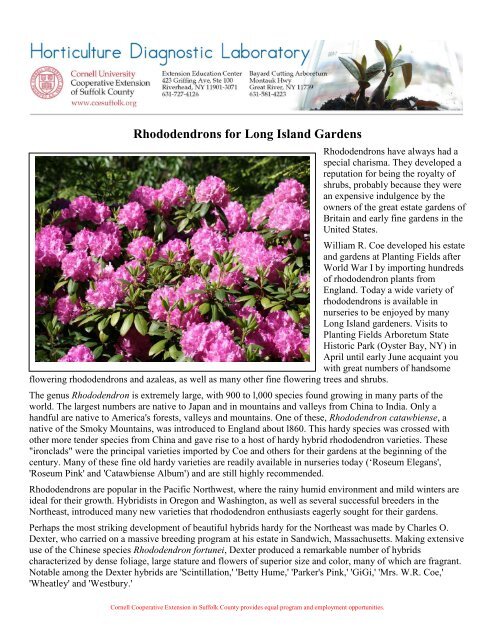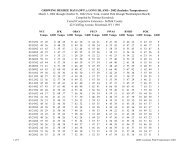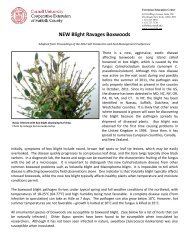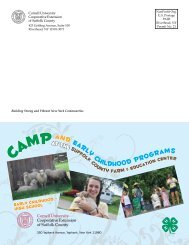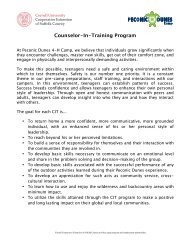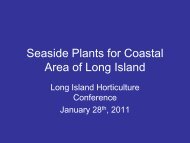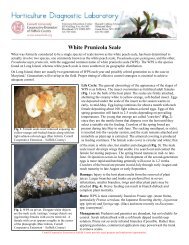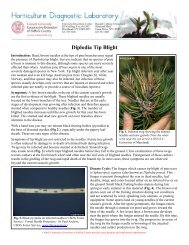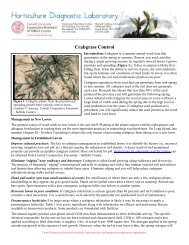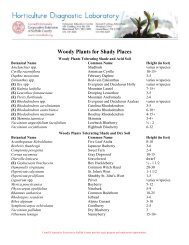Rhododendrons for Long Island Gardens - Cornell Cooperative ...
Rhododendrons for Long Island Gardens - Cornell Cooperative ...
Rhododendrons for Long Island Gardens - Cornell Cooperative ...
Create successful ePaper yourself
Turn your PDF publications into a flip-book with our unique Google optimized e-Paper software.
<strong>Rhododendrons</strong> <strong>for</strong> <strong>Long</strong> <strong>Island</strong> <strong>Gardens</strong><br />
<strong>Cornell</strong> <strong>Cooperative</strong> Extension in Suffolk County provides equal program and employment opportunities.<br />
<strong>Rhododendrons</strong> have always had a<br />
special charisma. They developed a<br />
reputation <strong>for</strong> being the royalty of<br />
shrubs, probably because they were<br />
an expensive indulgence by the<br />
owners of the great estate gardens of<br />
Britain and early fine gardens in the<br />
United States.<br />
William R. Coe developed his estate<br />
and gardens at Planting Fields after<br />
World War I by importing hundreds<br />
of rhododendron plants from<br />
England. Today a wide variety of<br />
rhododendrons is available in<br />
nurseries to be enjoyed by many<br />
<strong>Long</strong> <strong>Island</strong> gardeners. Visits to<br />
Planting Fields Arboretum State<br />
Historic Park (Oyster Bay, NY) in<br />
April until early June acquaint you<br />
with great numbers of handsome<br />
flowering rhododendrons and azaleas, as well as many other fine flowering trees and shrubs.<br />
The genus Rhododendron is extremely large, with 900 to l,000 species found growing in many parts of the<br />
world. The largest numbers are native to Japan and in mountains and valleys from China to India. Only a<br />
handful are native to America's <strong>for</strong>ests, valleys and mountains. One of these, Rhododendron catawbiense, a<br />
native of the Smoky Mountains, was introduced to England about l860. This hardy species was crossed with<br />
other more tender species from China and gave rise to a host of hardy hybrid rhododendron varieties. These<br />
"ironclads" were the principal varieties imported by Coe and others <strong>for</strong> their gardens at the beginning of the<br />
century. Many of these fine old hardy varieties are readily available in nurseries today (‘Roseum Elegans',<br />
'Roseum Pink' and 'Catawbiense Album') and are still highly recommended.<br />
<strong>Rhododendrons</strong> are popular in the Pacific Northwest, where the rainy humid environment and mild winters are<br />
ideal <strong>for</strong> their growth. Hybridists in Oregon and Washington, as well as several successful breeders in the<br />
Northeast, introduced many new varieties that rhododendron enthusiasts eagerly sought <strong>for</strong> their gardens.<br />
Perhaps the most striking development of beautiful hybrids hardy <strong>for</strong> the Northeast was made by Charles O.<br />
Dexter, who carried on a massive breeding program at his estate in Sandwich, Massachusetts. Making extensive<br />
use of the Chinese species Rhododendron <strong>for</strong>tunei, Dexter produced a remarkable number of hybrids<br />
characterized by dense foliage, large stature and flowers of superior size and color, many of which are fragrant.<br />
Notable among the Dexter hybrids are 'Scintillation,' 'Betty Hume,' 'Parker's Pink,' 'GiGi,' 'Mrs. W.R. Coe,'<br />
'Wheatley' and 'Westbury.'
Many of the more tender varieties, grown reliably in England and the Northwest, find the winters on <strong>Long</strong><br />
<strong>Island</strong> more severe than they can stand without injury or winter kill. Un<strong>for</strong>tunately, some varieties available in<br />
garden centers on <strong>Long</strong> <strong>Island</strong>, shipped here from West Coast growers, are not always reliably hardy. They<br />
should be tried only in the most protected locations.<br />
An excellent way to become acquainted with rhododendrons best suited <strong>for</strong> <strong>Long</strong> <strong>Island</strong> gardens and to learn<br />
how to grow them is to attend the meetings of the New York Chapter of the American Rhododendron Society.<br />
They are held at Planting Fields Arboretum. More in<strong>for</strong>mation on the Society can be obtained from their web<br />
site http://www.nyrhododendron.org/index.htm .Visitors are cordially welcomed. If you talk with<br />
Rhododendron Society members, you will soon learn the varieties they consider the "good doers," or most<br />
reliable, in their gardens. Some of those considered best <strong>for</strong> dependable hardiness and per<strong>for</strong>mance are listed in<br />
table below. New York Chapter of the American Rhododendron Society web site is another good place to get<br />
in<strong>for</strong>mation on dependable rhododendrons <strong>for</strong> our area.<br />
Ensure success with newly-purchased rhododendrons, or any other shrub or tree, by proper planting and after<br />
care. The old adage of preparing a five dollar hole <strong>for</strong> a 50-cent plant is still good advice. It is imperative to dig<br />
a hole at least three times the diameter of the root ball. It is good practice to prepare an entire bed area at the<br />
same time by incorporating organic matter (composted materials or peat moss) and rototilling the area to obtain<br />
a uni<strong>for</strong>m soil consistency.<br />
A plant should be placed with the root flare or root collar set at or slightly above the natural grade. The hole<br />
should be only as deep as the depth of the root ball. This insures that the root ball rests on firm soil to prevent<br />
settling after planting. <strong>Rhododendrons</strong> are surface rooting plants whose roots occupy the upper 3 - 5 inches of<br />
soil and need a loose, porous soil to permit adequate oxygen and moisture penetration <strong>for</strong> the roots. After<br />
backfilling the hole you can build a 3 or 4 inch high soil berm around the plant just beyond the root ball to help<br />
facilitate watering the first month or so. This should be removed after a few months. The rule of thumb is not to<br />
fertilize newly planted shrubs until one year after planting.<br />
If you purchase container-grown plants, you often find them pot-bound or approaching that condition. Cut or<br />
loosen some of the roots to disrupt the circular growth and <strong>for</strong>ce the plant to extend its roots into the<br />
surrounding mineral soil. You can obtain more detailed in<strong>for</strong>mation on planting trees and shrubs from the<br />
<strong>Cornell</strong> <strong>Cooperative</strong> Extension – Suffolk County web site in the leaflets titled How To Plant Trees and Shrubs<br />
and Planting and After-Care of Container Grown Plants. Printed copies of these leaflets are available from the<br />
Insect and Plant Disease Diagnostic Labs <strong>for</strong> a charge.<br />
The use of coarse mulch materials (wood chips, oak leaves or pine needles -- do not use peat moss as mulch) <strong>for</strong><br />
newly-planted rhododendrons helps ensure success in growth by retaining moisture and preventing deep<br />
freezing in winter. Keep the mulch several inches away from the stem of the plant. <strong>Rhododendrons</strong> require<br />
adequate moisture throughout the year to ensure good growth, flower bud initiation and prevention of<br />
desiccation and burning of foliage from deep freezing of roots and drying winter winds. Provide adequate water<br />
and you will enjoy beautiful rhododendrons year-round.<br />
LOW: (up to 3' in height)<br />
A List of <strong>Rhododendrons</strong> Suggested <strong>for</strong> Landscapes on <strong>Long</strong> <strong>Island</strong><br />
'Dora Amateis' - A compact, slow-growing hybrid with white flowers; blooms early.<br />
'Ginny Gee' - A dwarf small-leaved plant with two-toned pink flowers that cover the plant.<br />
'Ramapo' - A hardy dwarf early bloomer. The small violet-blue flowers are enhanced by small blue-green<br />
leaves.<br />
'Purple Gem' - Similar in plant <strong>for</strong>m to 'Ramapo' but with bright purple flowers in profusion.<br />
'Veesprite' - Tiny clusters of Persian rose flowers and small leaves on a delightful dwarf.<br />
'Mary Fleming' - Creamy yellow flowers streaked with salmon-pink, dark foliage in winter.<br />
A List of <strong>Rhododendrons</strong> Suggested <strong>for</strong> Landscapes on <strong>Long</strong> <strong>Island</strong>
LOW: (up to 3' in height) (continued from page 2)<br />
'Wyanokie' - A fine, small-flowered white with exceptionally good winter foliage, early flowering.<br />
R. keiskei - Pale yellow flowers cover this early blooming compact plant.<br />
R. yakusimanum - Highly prized rhododendron with slow growth and compact habit, pink buds open to white<br />
flowers.<br />
MEDIUM: (3' to 6' in height)<br />
'Pioneer' - Early flowering with rose-pink flowers in profusion. Small leaves, partly deciduous.<br />
R. mucronulatum - The earliest of all, blooming with Forsythia. '<strong>Cornell</strong> Pink' and 'Mucronulatum-Pink'<br />
seed-grown are both good color <strong>for</strong>ms - deciduous.<br />
R. carolinianum - Bell-shaped pink, lavender pink or rose flowers and small, glossy green leaves on a broad<br />
but upright plant.<br />
'P.J.M.' - An early flowering intense pinkish lavender that resembles R. carolinianum. The small leaves turn a<br />
mahogany-copper in late fall.<br />
'Windbeam' - A popular small-leaved variety that blooms with apricot-pink flowers changing to pure white<br />
flushed with light salmon. This is a reliable, hardy plant.<br />
'Boule de Neige' - A compact hybrid with pure white flowers in large clusters that appear early. Grows best<br />
with some shade.<br />
'Vulcan' - Heavy trusses of fiery red on a well-shaped mound of dark green pointed leaves.<br />
R. vaseyi - One of the loveliest deciduous native azaleas with flowers ranging from white to pink.<br />
TALL: (over 6' in height)<br />
'Betty Hume' - Large pink frilled and ruffled flowers; plant habit is one of the very best.<br />
'Blue Peter' - Frilled trusses of light lavender with a showy dark flare.<br />
'Cadis' - Fragrant light pink flowers on an attractive plant.<br />
'Catawbiense Album' - This has been a standard white <strong>for</strong> over a hundred years and is still a winner.<br />
'Everestianum' - Ruffled, lavender-rose flowers on an exceptionally hardy plant.<br />
'GiGi' - Trusses of up to l8 rosy-red flowers covered with deep red spotting. One of the best Dexters.<br />
'Great Eastern' - An attractive ruffled deep purplish-pink, paler in the center. Free flowering with large<br />
trusses.<br />
'Janet Blair' - Pink-white flowers with a light yellow blotch complement this very vigorous, well-rounded and<br />
branched plant.<br />
'Mars' - Deep tone hardy red and white stamens and open flowers of good substance. Needs some protection<br />
from afternoon sun.<br />
'Mrs. W.R. Coe' - Large flowers <strong>for</strong>m a dome-shaped truss of brilliant pink flowers with a crimson throat. A<br />
fine Dexter with glossy dark green leaves.<br />
'Parker's Pink' - Lightly scented 3-l/2" flowers are brilliant pink with heavy red spotting and white center -<br />
highly popular.<br />
'Roseum Pink' - Similar to 'Roseum Elegans' in hardiness and habit, but with a lovely pink flower.<br />
'Scintillation' - Fine pink flowers of heavy substance in mid-May. Has handsome foliage and good compact<br />
habit of growth.<br />
A List of <strong>Rhododendrons</strong> Suggested <strong>for</strong> Landscapes on <strong>Long</strong> <strong>Island</strong>
TALL: (over 6' in height) (continued from page 3)<br />
'Westbury' - Fairly late blooming large pink; open funnel-shaped flowers with nearly white edges. Very<br />
floriferous, well-branched plant.<br />
'Wheatley' - Frilled, lightly fragrant flowers are a delicate silvery pink shaded deeper on the edge and touched<br />
with yellow-green in the throat. Plants often grow more broad than high.<br />
R. <strong>for</strong>tunei - An outstanding plant covered with large, often fragrant pastel pink flowers in generous trusses.<br />
R. maximum - A native species of the Northeast, white to pink flowers, the last to bloom of the season; requires<br />
some shade.<br />
R. schlippenbachii - Called the Royal Azalea, a dense deciduous bush with pastel to rose pink, star-shaped<br />
flowers. Excellent.<br />
Resource: “<strong>Rhododendrons</strong> <strong>for</strong> <strong>Long</strong> <strong>Island</strong> <strong>Gardens</strong>”, by Gordon E. Jones, <strong>Long</strong> <strong>Island</strong> Gardening, May/June,<br />
1992, p. 3-5.<br />
9/2008 revised<br />
TK 9/2008, AW 2/2012


